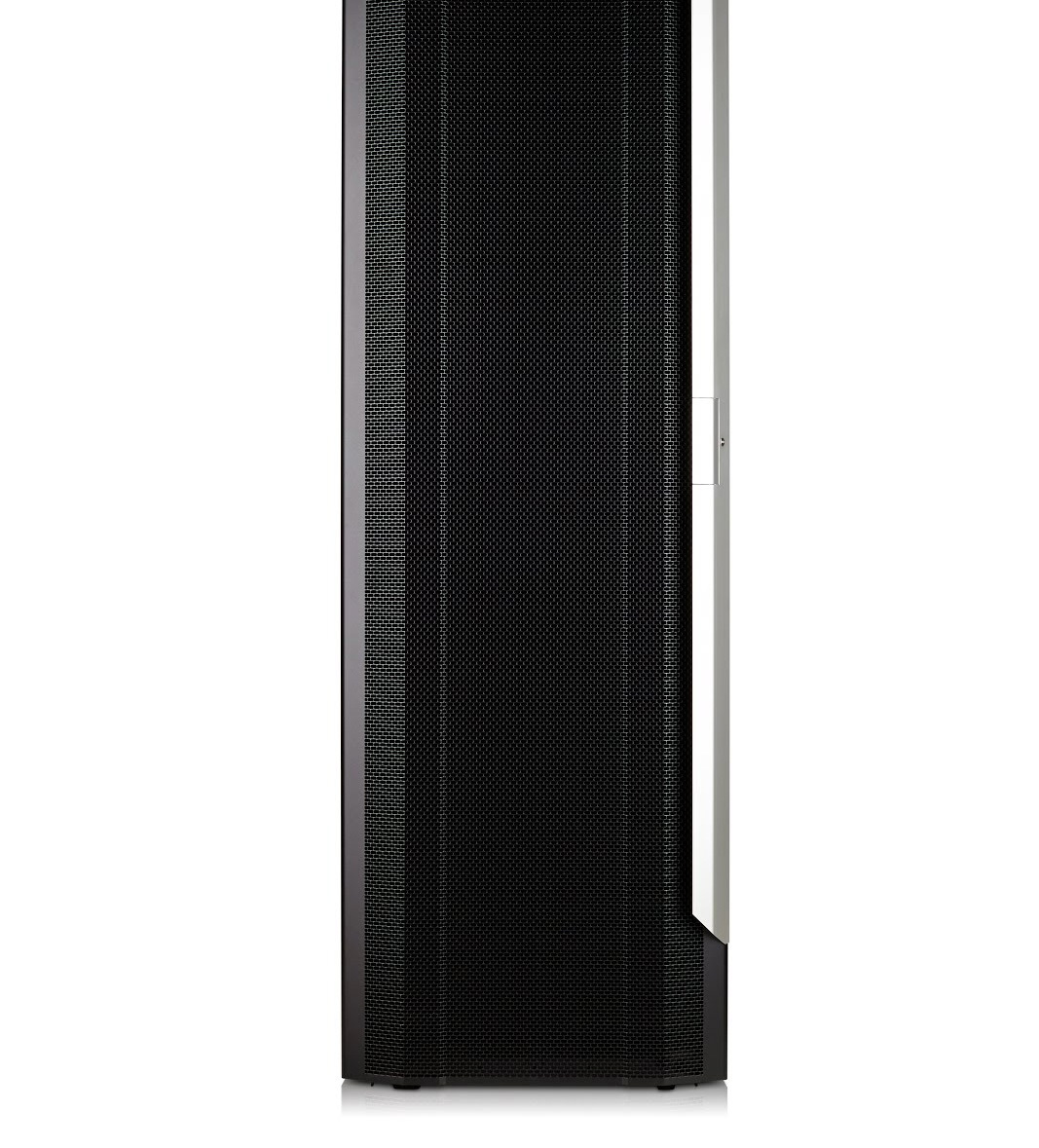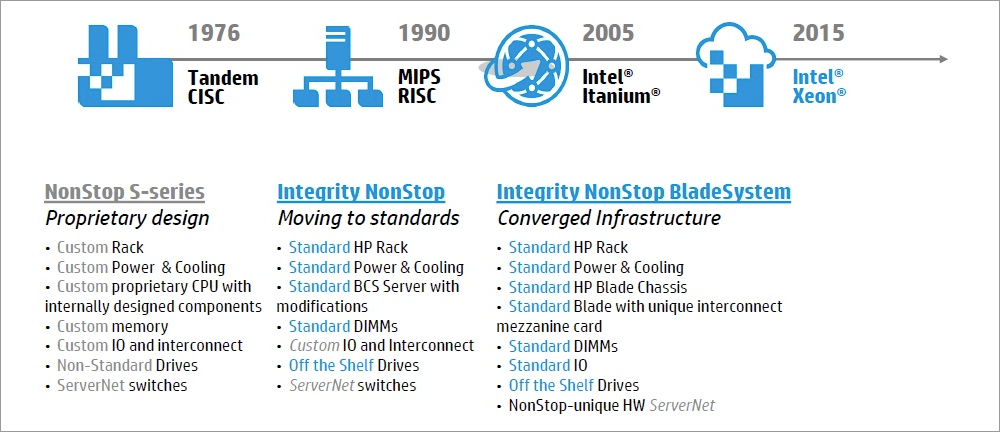HP Integrity NonStop X - 100% Resiliency for Standard Architecture Servers
At the end of 2011, we talked about the then-launched HP Odyssey project to create business-critical systems based on standard architecture processors. One of the goals of Odyssey was the release of fault-tolerant x86 Integrated NonStop HP Servers. The first such HP Integrity NonStop X NS7 X1 server using Xeon E5 processors was released this spring. Since the HP Integrity NonStop platform is much less known than the main series of business-critical HP Integrity Unix servers, it’s worth briefly telling about its development history and the features of these fault-tolerant servers.


The first NonStop server was launched back in 1976 by Tandem, which was founded two years earlier by a team of former HP engineers who developed the HP3000 series minicomputers. The creators of NonStop wanted to bring to the market a server for the most critical tasks (primarily for banks and telecommunications), which would ensure maximum scalability of performance, data integrity and constant availability of applications.
To do this, they used massive-parallel architecture (MPP), which allows systems to be scaled to 4080 processors and 255 computing nodes, various self-testing and error localization mechanisms, disk mirroring and duplication of the main hardware components of the server. From other server architectures, including business-critical Unix servers, NonStop is distinguished by the absence of shared resources and a system bus (share nothing), the use of a messaging mechanism, a high degree of software and hardware integration, duplication at different levels. As a result, NonStop servers provide the highest IDC server availability level Level 4 (AL4) (for more information on NonStop technologies, read here ).

HP NonStop Evolution
As mentioned above, the first generation NonStop came out in 1976. These were microcomputers, which consisted entirely of proprietary components, including CISC processors, a memory subsystem, I / O, interconnects, disks, power supplies and fans and racks. To combine NonStop nodes into a single massively-parallel system, NonStop used the specialized ServerNet network technology developed by Tandem, which allows building a switched factory for linking nodes into a massively parallel system.
In the early 1990s, Tandem released the second generation NonStop S-Series, which used MIPS RISC processors instead of CISC, and in 1997 Compaq bought this company. A year later, Compaq bought Digital Equipment (DEC) and then announced plans to move NonStop to Alpha's RISC processors, which DEC developed. These plans were not implemented because in 2001 Compaq relied on Itanium and abandoned the further development of Alpha. In the same year, HP bought Compaq and, as a result, NonStop was included in our company's critical business server business product portfolio. In 2005, HP released the first HP Integrity NonStop to use Itanium processors. The third generation NonStop used standard processors and memory modules, but ServerNet switches, I / O subsystem and interconnects remained proprietary in it. Finally, five years ago, along with the migration of the main HP Integrity Unix server series to blade architectures, the HP Integrity NonStop BladeSystem also appeared using the standard BladeSystem c7000 chassis and HP Integrity Blade BL860c blades. In this generation of HP Integrity NonStop based on Itanium 9300/9500, only ServerNet interconnects remained the proprietary components, and the rest of the hardware was taken from standard HP BladeSystem c-Class.
Introduced on March 30, 2015, the fifth generation of HP Integrity NonStop X uses the HP ProLiant BL460c dual-socket blades with quad-core Intel Xeon E5 2600 v2 processors and 64 - 192 GB of RAM as the hardware platform. Like the fourth-generation HP Integrity NonStop BladeSystem blades with Itanium processors, the HP Integrity NonStop X NS7 X1 blades are installed in the BladeSystem c7000 chassis, but they are half the height of the BL860c i4, so the HP Integrity NonStop 16-node configuration (with 32 physical processors) only takes up one chassis, not two. To simplify the transition of NonStop users to the new architecture, HP optimized the entire NonStop software stack for x86,

HP NonStop X Network Architecture
In addition to changing the processor architecture, HP Integrity NonStop X differs from the previous generation of servers by replacing the branded ServerNet interconnect with the standard Infiniband, which almost 25 times improved interconnect bandwidth up to 56 Gb / s, and significantly reduced delays in exchanging packets between server nodes. Each blade on the HP Integrity NonStop X NS7 X1 is equipped with an InfiniBand mezzanine card, and the BladeSystem c7000 chassis with two InfiniBand 4X FDR switches, which form a dual fail-safe switched factory. It is worth noting that HP, along with the use of InfiniBand technology, continues to use a number of important functions in HP Integrity NonStop X that were previously implemented in previous generations of NonStop using ServerNet technologies, such as direct access to Remote Direct Memory Access (RDMA),
Also, I / O performance on sequential and random read operations in the new generation of HP Integrity NonStop has grown by about 25% due to the use of a new generation of solid state drives and disk interfaces. According to the results of the Order Entry test, when switching to x86, the performance of HP Integrity NonStop applications improves one and a half times.
For those customers who, for whatever reason, prefer to use HP Integrity NonStop on Itanium, HP will continue to produce fourth-generation servers under the brand name HP Integrity NonStop i and possibly will equip them with the next generation Itanium, codenamed Kittson (Gartner analysts believe that Kittson, which is expected to be released next year, will be the last generation of Itanium and Intel will not further develop this series of processors). However, in this HP Integrity NonStop series, ServerNet interconnect will continue to be used, rather than the much faster InfiniBand.
Thus, the new generation of HP Integrity NonStop X servers provides the highest level of fault tolerance and scalability of business-critical applications among x86-based servers, and significantly improves the performance of NonStop applications.


The first NonStop server was launched back in 1976 by Tandem, which was founded two years earlier by a team of former HP engineers who developed the HP3000 series minicomputers. The creators of NonStop wanted to bring to the market a server for the most critical tasks (primarily for banks and telecommunications), which would ensure maximum scalability of performance, data integrity and constant availability of applications.
To do this, they used massive-parallel architecture (MPP), which allows systems to be scaled to 4080 processors and 255 computing nodes, various self-testing and error localization mechanisms, disk mirroring and duplication of the main hardware components of the server. From other server architectures, including business-critical Unix servers, NonStop is distinguished by the absence of shared resources and a system bus (share nothing), the use of a messaging mechanism, a high degree of software and hardware integration, duplication at different levels. As a result, NonStop servers provide the highest IDC server availability level Level 4 (AL4) (for more information on NonStop technologies, read here ).

HP NonStop Evolution
As mentioned above, the first generation NonStop came out in 1976. These were microcomputers, which consisted entirely of proprietary components, including CISC processors, a memory subsystem, I / O, interconnects, disks, power supplies and fans and racks. To combine NonStop nodes into a single massively-parallel system, NonStop used the specialized ServerNet network technology developed by Tandem, which allows building a switched factory for linking nodes into a massively parallel system.
In the early 1990s, Tandem released the second generation NonStop S-Series, which used MIPS RISC processors instead of CISC, and in 1997 Compaq bought this company. A year later, Compaq bought Digital Equipment (DEC) and then announced plans to move NonStop to Alpha's RISC processors, which DEC developed. These plans were not implemented because in 2001 Compaq relied on Itanium and abandoned the further development of Alpha. In the same year, HP bought Compaq and, as a result, NonStop was included in our company's critical business server business product portfolio. In 2005, HP released the first HP Integrity NonStop to use Itanium processors. The third generation NonStop used standard processors and memory modules, but ServerNet switches, I / O subsystem and interconnects remained proprietary in it. Finally, five years ago, along with the migration of the main HP Integrity Unix server series to blade architectures, the HP Integrity NonStop BladeSystem also appeared using the standard BladeSystem c7000 chassis and HP Integrity Blade BL860c blades. In this generation of HP Integrity NonStop based on Itanium 9300/9500, only ServerNet interconnects remained the proprietary components, and the rest of the hardware was taken from standard HP BladeSystem c-Class.
Introduced on March 30, 2015, the fifth generation of HP Integrity NonStop X uses the HP ProLiant BL460c dual-socket blades with quad-core Intel Xeon E5 2600 v2 processors and 64 - 192 GB of RAM as the hardware platform. Like the fourth-generation HP Integrity NonStop BladeSystem blades with Itanium processors, the HP Integrity NonStop X NS7 X1 blades are installed in the BladeSystem c7000 chassis, but they are half the height of the BL860c i4, so the HP Integrity NonStop 16-node configuration (with 32 physical processors) only takes up one chassis, not two. To simplify the transition of NonStop users to the new architecture, HP optimized the entire NonStop software stack for x86,

HP NonStop X Network Architecture
In addition to changing the processor architecture, HP Integrity NonStop X differs from the previous generation of servers by replacing the branded ServerNet interconnect with the standard Infiniband, which almost 25 times improved interconnect bandwidth up to 56 Gb / s, and significantly reduced delays in exchanging packets between server nodes. Each blade on the HP Integrity NonStop X NS7 X1 is equipped with an InfiniBand mezzanine card, and the BladeSystem c7000 chassis with two InfiniBand 4X FDR switches, which form a dual fail-safe switched factory. It is worth noting that HP, along with the use of InfiniBand technology, continues to use a number of important functions in HP Integrity NonStop X that were previously implemented in previous generations of NonStop using ServerNet technologies, such as direct access to Remote Direct Memory Access (RDMA),
Also, I / O performance on sequential and random read operations in the new generation of HP Integrity NonStop has grown by about 25% due to the use of a new generation of solid state drives and disk interfaces. According to the results of the Order Entry test, when switching to x86, the performance of HP Integrity NonStop applications improves one and a half times.
For those customers who, for whatever reason, prefer to use HP Integrity NonStop on Itanium, HP will continue to produce fourth-generation servers under the brand name HP Integrity NonStop i and possibly will equip them with the next generation Itanium, codenamed Kittson (Gartner analysts believe that Kittson, which is expected to be released next year, will be the last generation of Itanium and Intel will not further develop this series of processors). However, in this HP Integrity NonStop series, ServerNet interconnect will continue to be used, rather than the much faster InfiniBand.
Thus, the new generation of HP Integrity NonStop X servers provides the highest level of fault tolerance and scalability of business-critical applications among x86-based servers, and significantly improves the performance of NonStop applications.
